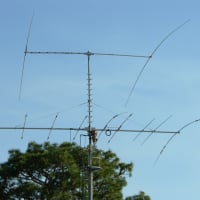SmartSDR v4.1.3 | SmartSDR v4.1.3 Release Notes
SmartSDR v3.10.15 | SmartSDR v3.10.15 Release Notes
The latest 4O3A Genius Product Software and Firmware
Need technical support from FlexRadio? It's as simple as Creating a HelpDesk ticket.
Possible problem on 10 meters
I have always noticed some spurs in the transmit window with my 6600M. I was told this was normal because the display is taken before the filters. Oddly enough, it is extremely bad on 10 meters. Yet spurs are barely noticeable on 20 meters.
I often wonder if it is present on the signal when received by another station.
I find it odd other bands don't exhibit this nearly as bad.
James
WD5GWY
I did mention it once with Customer service. That's who said it was normal.
Forgot to mention, this is into a good dummy load.
Comments
-
Could it be that between your 2 above displays, your antenna gains are different and your vertical and horizontal scales are different? With your 20M scales expanded, and antenna gain increased to 8dB (to make both the same), perhaps the 2 displays will look more alike.
1 -
That is something different to try.
Still there. Just not as intense.
0 -
Here it is with the same bandwidth on 20 meters. It actually makes the display even cleaner.
0 -
I even changed both bandwidths to 100Khz and both vertical scales to 120 to 0.
Still the same results. Only the 10 meter spurs were not quite so pronounced.
0 -
Hi James, you can't infer too much from that display. To see what your signal is really doing, you want to put your rig into Full Duplex (FDX) and listen (and look) on a second panadapter. Ken, NM9P has some really good videos on doing that. He shows this in the context of adjusting your TX equalizer, but you can also check other aspects of signal quality that way.
I would transmit into a dummy load and reduce power until the received signal shows as S9. This should show very clearly what your transmitted signal looks like.
I think of it like my novice days. My signal would be distorted in the receiver if I didn't hit the mute switch when switching from RX to TX. My sig was actually OK, but the RX was saturated and showing 40 or more over 9. Any artifacts that were down below normal hearing, could be clearly heard, but only in my own receiver.
In the case of Flex radios, the dynamic range is really high, but you are still driving the ADC pretty hard. Not hard enough to overload or damage anything, but hard enough to show artifacts that are either way way down, or possibly not there at all on your transmitted signal. By giving yourself a ceiling of S9 during this testing, you will be able to see what others see if they were receiving you at S9.
1 -
Hi James,
Your original post shows 10 meters scale (right side of panadapter) at -70 to -130. You can see the top of the TX signal is cut off.
The second picture on 20 meters the panadapter scale is set to 0 to -130, a 70 dB difference in scale. Apples and oranges as they say.
You will see more spurs on the -70 to -130 setting since you are zooming in. Try adjusting the scale on 10 meters on TX using the up and down arrows at top of panadapter scale until you see top of TX signal. Then measure the level at top of TX vs level of spurs. You’ll find it looks better and the spurs will appear at least 60 dB lower than your TX signal.
Looking at your adjusted 10 meter picture the TX signal is at -30 dB and the highest “spur” is at -110 dB. That is an 80 dB difference. While the TX panadapter is not a true reflection of your signal, an 80 dB difference at 1500 watts out would be .000015 watt.
73
Dave wo2x
0 -
Thank you Dave. I do understand what you are saying. At first I found it odd that the spurs were more pronounced/visible on 10 meters than the lower bands. Even with the same settings in bandwidth and scale as well as the same tune power ( 5 watts) that holds true. At full power output they are greater still. And the results are the same. More pronounced on 10 meters and less and less, as you go lower in frequency/band.
I believe it is the nature of the finals used in the PA. They cannot be expected to be linear across such a wide range of frequencies. I believe they are more efficient at lower, rather than higher frequencies.
James
WD5GWY
0 -
Yes but filtering helps and again, the if you looks, even though it looks “bad”, when you put it in context as far as amplitude they are non-consequential.
73
Dave wo2x
1 -
This is a good question and one that is often asked.
Your FlexRadio is an amazing piece of test equipment and it can see very weak signals.
Most radios are like this, but with them, you can't see the same details while in transmit.
If you take any other HF radio and feed it into a spectrum analyzer you might see it is actually worse.
So, short story, it is working as designed and exceeds FCC specs. :)
0 -
The main reasons you see this are:
- The receiver is 'ON' during TX.
- RX and TX functions share PCBs, and components, and the receiver is inside a Faraday cage with a 100W transmitter.
There is also some mixing of on-air and other signals in the receiver that result in spurs or other anomalies that don't get amplified in the PA. But generally, what you see in the filter passband during TX represents what is going out over the air. As Mike and Dave mention, even outside the passband, most all of these signals are below the -60dBc requirement.
BTW: We think it is an important feature to observe the on-air signal through the receiver during TX, even if it means educating customers about which signals are real or not. We don't FFT the transmit signal and display only what is sent to the PA like other radios, a practice that may mask actual issues in the PA.
73,
Dan, N7HQ
3 -
Dan, thank you for the detailed explanation.
James
WD5GWY
0
Leave a Comment
Categories
- All Categories
- 381 Community Topics
- 2.1K New Ideas
- 633 The Flea Market
- 8.3K Software
- 131 SmartSDR+
- 6.4K SmartSDR for Windows
- 185 SmartSDR for Maestro and M models
- 430 SmartSDR for Mac
- 272 SmartSDR for iOS
- 259 SmartSDR CAT
- 197 DAX
- 382 SmartSDR API
- 9.4K Radios and Accessories
- 42 Aurora
- 265 FLEX-8000 Signature Series
- 7.2K FLEX-6000 Signature Series
- 955 Maestro
- 56 FlexControl
- 866 FLEX Series (Legacy) Radios
- 929 Genius Products
- 464 Power Genius XL Amplifier
- 340 Tuner Genius XL
- 125 Antenna Genius
- 297 Shack Infrastructure
- 209 Networking
- 461 Remote Operation (SmartLink)
- 144 Contesting
- 788 Peripherals & Station Integration
- 140 Amateur Radio Interests
- 1K Third-Party Software









